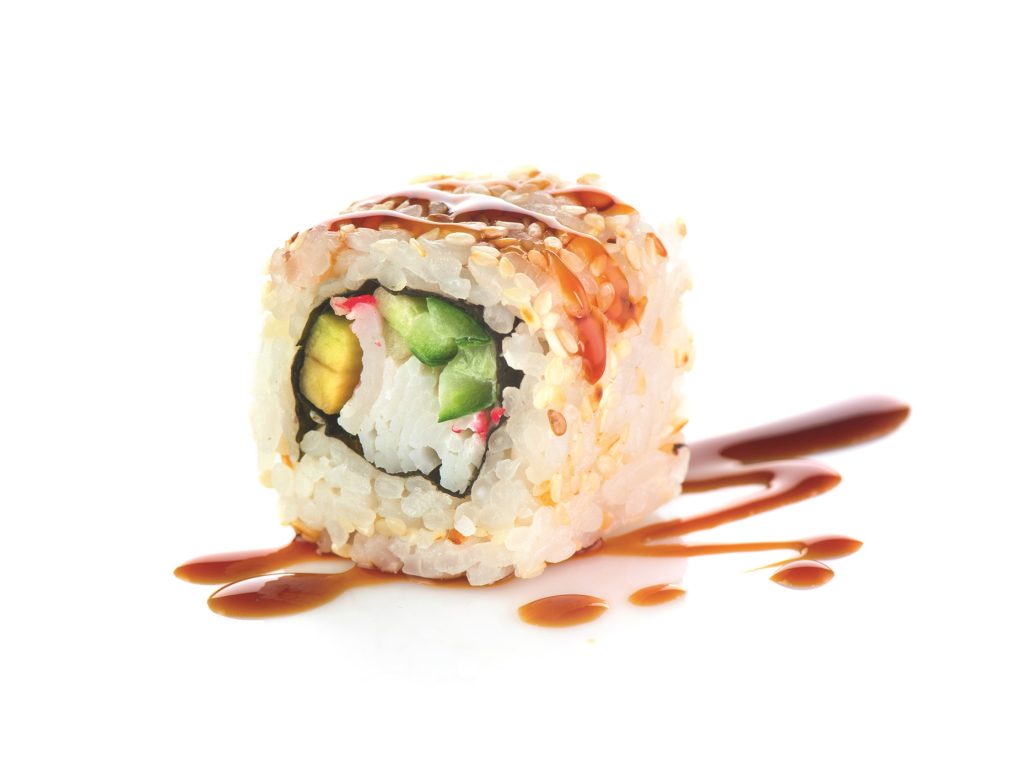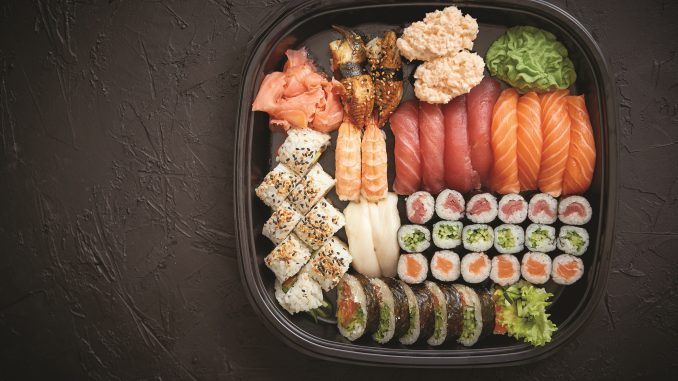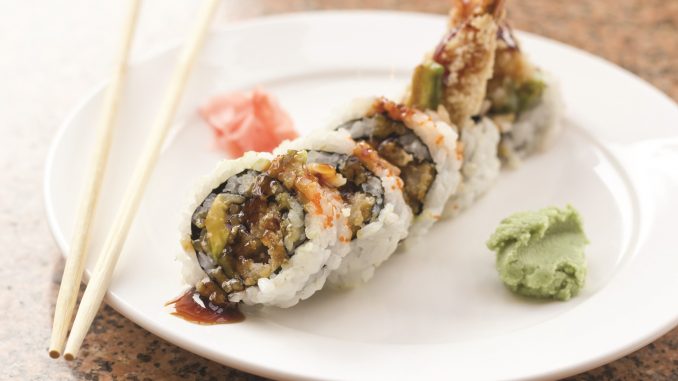Sushi Puts Deli Sales on a Roll
June 1, 2019 | 7 min to read
In North Dakota, chef-prepared sushi at Hugo’s Family Marketplace has gained significant popularity, generating 2 to 3 percent of total store sales since introducing the Snowfox brand. As consumer acceptance of sushi has increased, driven by diverse demographics, the U.S. foodservice sushi industry has grown to $22 billion by 2019. Retailers are adapting their offerings to attract younger generations, demonstrating that even kids now favor traditional sushi varieties over novelty options.

Deep in the heart of America, in the land-locked, meat-and-potatoes state of North Dakota, customers seek out chef-prepared sushi at Hugo’s Family Marketplace. The 10-location supermarket chain headquartered in Grand Fork introduced Snowfox brand sushi, a franchise of independently-operated Grab-N-Go Cafes by JFE Franchising Inc., in Houston, TX, in March. The cafe is run by a trained chef and operates from counter space atop a service case within Hugo’s deli adjacent to pre-prepared and made-to-order salads and sandwiches. Today, long since the 1950’s when Japanese restaurants first served sushi to California residents and the 1960’s when New York Times restaurant critic Craig Claiborne wrote sushi may be too ‘far out’ for American palates, Midwest retailer Hugo’s sushi program is so popular that it represents 2 to 3 percent of total store sales, according to JFE, and brings in five digits in sales per store each week.
“Sushi was still viewed as exotic when we started in 2005. Now, customers notice if a retailer doesn’t offer sushi,” says Stacy Kwon, president of JFE Franchising, which operates nearly 900 franchise locations in major retailers nationwide, such as Kroger, Costco, Albertsons, Fresh Market and King Soopers.
Sushi originated in Southeast Asia in the 8th century as a method to preserve fish., which was wrapped in fermented rice and stored for up to a year. The fish was then eaten and rice was discarded. During its early years in the U.S., sushi was thought to be synonymous with raw fish. Yet, in reality, it’s a dish of vinegared rice topped and filled with a variety of ingredients, including vegetables and a broad range of raw and cooked seafood.
Over the past five years, the foodservice sushi industry in the U.S. has grown by 4.8 percent to reach $22 billion in 2019, according to the February 2019-published report, Sushi Restaurants Industry in the U.S., by IBISWorld, a market research firm headquartered in Los Angeles.
Behind this, research shows there is a broad demographic of customers that buys sushi. For example, while 39 percent of those living in urban areas are interested in Japanese/sushi, according to The Power of Foodservice at Retail 2018, published by the Arlington, VA-based Food Marketing Institute, 34 percent of those in suburban areas are, too, followed by 26 percent in small towns and 25 percent in rural locations. Similarly, 46 percent of Millennials are attracted to Japanese/sushi, followed by 32 percent of Gen X-ers and 19 percent of Boomers. Perhaps Generation Alpha, those born after 2010, will be most influential when it comes to sushi purchases.
“Five years ago, we wanted to attract kids to the kiosk in hopes of getting their parents to buy sushi,” recalls Patrick Vanlehn, president and CEO of Royal Oak, MI-based Sushi Kabar, a supplier of sushi to supermarkets via customized franchise operations. “To do this, we flattened slices of wheat bread, rolled turkey up inside sushi-style and topped this with a dollop of ranch dressing-flavored cream cheese and a Goldfish cracker. We did this in a couple of store locations. What we discovered is that the kids were attracted all right; they asked for the spicy tuna rolls.”

A Menu Of Programs
Sushi is a rapidly-growing category, outpacing other, older deli sub-categories, according to Breana Jones, director of marketing for Charlotte, NC-based Hissho Sushi, which provides sushi bars to venues such as supermarkets. “This is driven by the changing demographics of the country, evolving pallets and the push to have a broader variety of prepared foods in store. At the same time, it is essential that offerings are not just delicious and restaurant-quality, but conveniently packaged and able to be eaten on the go,” she says.
One of the most eye-catching and potentially revenue-enhancing types of supermarket sushi programs is a chef-made operation in-store. Companies such as JFE, Sushi Kabar and Hissho provide these turnkey solutions.
“Retailers provide the capital equipment, a section in their refrigeration and dry storage areas, and preparation and selling space. We provide all the other elements, which include ingredients, food safety licensure as required by each state in which we operate and, of course, trained labor. Even though we are branded separately, we still operate within a retailer’s stores and while not managed by, have strong bonds and work harmoniously with the deli staff both in-store and at the corporate level,” explains Vanlehn about the Sushi Kabar program.
Chefs that apply to work for JFE cafés attend a two-week sushi academy training program, says Kwon. “Our in-store chefs and their staff are backed by a team of quality controllers, food safety experts, marketers, number crunchers and nutritionists that are all there to help support the franchisee as they implement a unique plan for each of our partner stores. A key part of our program is customer engagement and daily sampling, especially at peak hours such as 11 a.m. to 1 p.m. and from 4 to 6 p.m.”
Retailers who want to test the waters with a sushi program can start with direct store delivery (DSD) of the product from a company with a central commissary.
“When delis are making $1,200 to $1,500 per week on sushi, that shows the store has enough volume to convert to a full chef location. This conversion, moving to a chef in store, can double or triple sushi sales,” says Sushi Kabar’s Vanlehn.
Frozen sushi is a solution for deli operators in settings too far from DSD operators and those unsure if potential sales volume can support a full-time sushi chef.
“Our secret is in the rice,” says Matt Christenson, sales manager for Seattle-headquartered Banzai Sushi, which offers a refresh and display sushi program under its Mojo brand. “We have an innovative four-step process, which retains the texture and integrity of the rice. The product is all pre-cooked. It takes three hours to thaw and has a five-day shelf life once thawed. Operators can thaw as much of the sushi as they need on a daily basis, which maintains freshness, reduces shrink and solves out-of-stock issues.”
The company offers four flavors in eight-piece tray portions: Classic California Roll, California Cream Cheese Roll, Spicy Crab Roll and the newest introduced six months ago, a Coconut Shrimp Roll.

Global Flavor Profiles
The essentials to having a great deli sushi program is variety, says Hissho Sushi’s Jones. “You need to have a mixture of the staples that people know—like the California Roll—and new items. There should be enough to appeal to a wide range of tastes, something for everyone in a household. We make sure that our chefs prepare a wide variety of options every day. There will always be cooked, raw and vegetarian (no fish at all) rolls as well as poke and appetizer salads.”
Poke, a Hawaiian staple made of marinated fish served over rice and under fresh veggies, is still on trend, Jones adds. The company has multiple SKUs in its portfolio, each growing in popularity. Another big trend is plant-based proteins.
“We recently launched two new rolls—the Veggie TNT and Spicy Pepper—that use roasted red bell peppers. It mimics the look and consistency of tuna, but is a vegetarian (non-fish) option. People love them,” says Jones.
In the last few years, JFE has introduced a poke roll, sushi taco, sushi donut and sushi sandwich. In addition, the company will customize rolls to fit the flavor profiles of a deli’s customers. This has included, for example, a Baja sushi roll in Southern California, Tex-Mex roll with pica de gallo in the Southwest, Jambalaya roll in the South and Buckeye Roll in Ohio. However, JFE’s Snowfox brand New York Crunch Roll remains its most popular. This roll is filled with avocado, crab salad, cucumber and fried onions, topped with spicy mayo and sweet sauce.
“New flavors are important to draw customers in, even if once they get to the counter they still purchase their favorite California roll,” says Kwon.
It’s All About The Theater
The best place to display and merchandise sushi not in its own dedicated kiosk, bar or cafe is packaged in single-serve trays in the grab-and-go case next to sandwiches and salads. Similarly, a franchise operation is best located either in-line with other supermarket deli prepared foods or as a separate freestanding aisle near the grab-and-go case. The latter is what Sushi Kabar’s Vanlehn recommends.
“Chef-prepared sushi is all about the theater, so it’s important to be in a very visible high-traffic area of the supermarket’s deli,” says Vanlehn.
As for the product display itself, be sure to include nigiri sushi, the kind made with raw fish.
“Nigiri will bring people to the case because it’s so beautiful. That’s why it should be the center of a display planogram, along with other specialty raw rolls, even if it’s not a big seller,” recommends JFE’s Kwon. “Place basic and fully-cooked rolls, like California Rolls, to the right and crunch-type and specialty cooked rolls to the left. On the upper level of the case, feature appetizers like seaweed salad, poke, dumplings and spring rolls and items on promotions to the left, combo menu selections and party trays in the center and custom items as well as extra sauces like wasabi and spicy mayo to the right. The correct type of visual merchandising can increase sales 30 to 35 percent. ” DB
6 of 15 article in DeliBusiness June/July 2019

